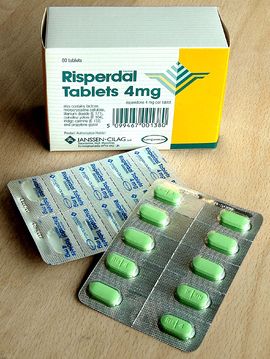Risperidone: Difference between revisions
No edit summary |
paragraph on each different use would make a very long article indeed, remedying this |
||
| Line 19: | Line 19: | ||
}} |
}} |
||
[[Image:Risperdal tablets.jpg|right|thumb|270px|Risperdal tablets]] |
[[Image:Risperdal tablets.jpg|right|thumb|270px|Risperdal tablets]] |
||
'''Risperidone''' (sold under the trade names '''Belivon''', '''Rispen''' and '''Risperdal''' in the United States) is an [[atypical antipsychotic]] [[medication]] developed by [[Janssen Pharmaceutica]]. It was approved by the United States [[Food and Drug Administration]] (FDA) in [[1993]]. Risperidone is most often used to treat delusional psychosis (including [[schizophrenia]]), but, like other atypical antipsychotics, it is also used to treat some forms of [[bipolar disorder]], [[psychotic depression]], [[obsessive-compulsive disorder]] |
'''Risperidone''' (sold under the trade names '''Belivon''', '''Rispen''' and '''Risperdal''' in the United States) is an [[atypical antipsychotic]] [[medication]] developed by [[Janssen Pharmaceutica]]. It was approved by the United States [[Food and Drug Administration]] (FDA) in [[1993]]. Risperidone is most often used to treat delusional psychosis (including [[schizophrenia]]), but, like other atypical antipsychotics, it is also used to treat some forms of [[bipolar disorder]], [[psychotic depression]], [[obsessive-compulsive disorder]], [[Tourette syndrome]], and generally lower doses for [[autism]]. <ref name="Samuel Curtis">{{cite press release |
||
Generally lower doses are used for [[autistic spectrum]] disorders than are used for [[schizophrenia]] and other forms of [[psychosis]]; risperidone has received approval from the Food and Drug Administration for symptomatic treatment of irritability in autistic children and adolescents.<ref name="Samuel Curtis">{{cite press release |
|||
|publisher=FDA |
|publisher=FDA |
||
|date=[[October 2]] [[2006]] |
|date=[[October 2]] [[2006]] |
||
Revision as of 04:01, 27 April 2007
 | |
| File:Risperdal.gif | |
| Clinical data | |
|---|---|
| Pregnancy category |
|
| Routes of administration | Oral and extended-release intramuscular injection |
| ATC code | |
| Legal status | |
| Legal status | |
| Pharmacokinetic data | |
| Bioavailability | 70% (oral) |
| Metabolism | Hepatic (CYP2D6-mediated) |
| Elimination half-life | 3–20 hours |
| Excretion | Urinary |
| Identifiers | |
| |
| CAS Number | |
| PubChem CID | |
| DrugBank | |
| CompTox Dashboard (EPA) | |
| ECHA InfoCard | 100.114.705 |
| Chemical and physical data | |
| Formula | C23H27FN4O2 |
| Molar mass | 410.485 g/mol g·mol−1 |

Risperidone (sold under the trade names Belivon, Rispen and Risperdal in the United States) is an atypical antipsychotic medication developed by Janssen Pharmaceutica. It was approved by the United States Food and Drug Administration (FDA) in 1993. Risperidone is most often used to treat delusional psychosis (including schizophrenia), but, like other atypical antipsychotics, it is also used to treat some forms of bipolar disorder, psychotic depression, obsessive-compulsive disorder, Tourette syndrome, and generally lower doses for autism. [2]
Janssen patent on Risperdal expires on December 29, 2007, opening the market for cheaper generic versions of the drug from other companies.
Side effects
Common side effects include nausea, anxiety, dizziness, insomnia, low blood pressure, muscle stiffness, muscle pain, sedation, tremors, and increased salivation. Risperidone has been associated with minimal to moderate weight gain, with one study finding that 26 to 38 percent of participants on the drug experienced weight gain.[3] It has also been known to cause sexual dysfunction such as retrograde ejaculation.
Occasionally breast tenderness and eventually lactation in both genders may occur. Many antipsychotics are known to increase prolactin because they inhibit dopamine. However, risperidone is known to increase prolactin to a greater extent than most other antipsychotics, such as quetiapine. It is thought that once risperidone raises prolactin, it may cause tumors in the pituitary gland. This may recur even if the patient has switched to a different antipsychotic.[4]
Like all antipsychotics, risperidone can potentially cause tardive dyskinesia (TD), extrapyramidal symptoms (EPS), and neuroleptic malignant syndrome (NMS), although the risk is generally less than for the older typical antipsychotics.
Also, like all atypical antipsychotics, risperidone can trigger diabetes and more serious conditions of glucose metabolism, including ketoacidosis and hyperosmolar coma.[5]
Pharmacology

Risperidone is a very strong dopamine blocker (antagonist); i.e., it inhibits functioning of postsynaptic dopamine receptors.
Risperidone also acts as a 5-HT2A antagonist, and can be used to quickly and effectively block the effects of 5-HT2A agonist drugs such as LSD. However, the use of antipsychotics on people under the influence of LSD is reportedly extremely unpleasant, with some describing it as a "chemical straightjacket." As a result, Valium is often recommended to reduce the anxiety of a bad trip.
It reaches peak plasma levels quickly regardless of whether it is administered as a liquid or pills. The strong dopamine-blocking reaction is known to make some people feel nauseated if they do things that normally trigger the dopamine response, such as eat a pleasing meal or experience orgasm. Risperidone is metabolised fairly quickly so this potential for nausea subsides usually in two to three hours.
References
- ^ "FDA-sourced list of all drugs with black box warnings (Use Download Full Results and View Query links.)". nctr-crs.fda.gov. FDA. Retrieved 22 Oct 2023.
- ^ "FDA Approves the First Drug to Treat Irritability Associated with Autism, Risperdal" (Press release). FDA. October 2 2006. Retrieved 2006-10-02.
{{cite press release}}: Check date values in:|date=(help) - ^ Vanina; et al. (July 2002). "Body Weight Changes Associated With Psychopharmacology". Psychiatric Services. 53. American Psychiatric Association: 842–847.
{{cite journal}}: Explicit use of et al. in:|author=(help) - ^ Szarfman A, Tonning J, Levine J, Doraiswamy P (2006). "Atypical antipsychotics and pituitary tumors: a pharmacovigilance study". Pharmacotherapy. 26 (6): 748–58. PMID 16716128.
{{cite journal}}: CS1 maint: multiple names: authors list (link) - ^ "FDA Warning Letter" (Press release). FDA. April 19 2004. Retrieved 2006-10-02.
{{cite press release}}: Check date values in:|date=(help)
External links
- Drugs.com Professional information on risperidone
- Drugs.com Consumer information on risperidone
- Janssen L.P. official web site on Risperdal (risperidone)
- PubChem Substance Summary: Risperidone National Center for Biotechnology Information.
